GLBenchmark 2.5 Performance on iOS and Android Devices
by Anand Lal Shimpi & Brian Klug on July 31, 2012 8:00 PM EST- Posted in
- Smartphones
- GLBenchmark
- Mobile
- Tablets
- SoCs
Smartphone Performance in GLBenchmark 2.5
Thus far there's no A5X equivalent in an iPhone, making the A5 the highest performing option from Apple in these charts. Clock speeds (and likely power management profiles) are lower on the A5 in the iPhone 4S than in the iPad 2, so performance should be a bit lower here than what you saw on the previous page.
The A5 has a significant fill rate advantage, however triangle throughput ranges from middle of the road to barely in the lead. In many cases NVIDIA's Tegra 3 or Qualcomm's S4 pulls ahead in triangle throughput.
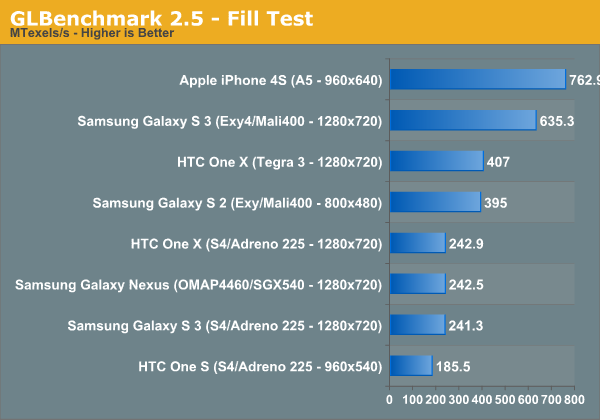
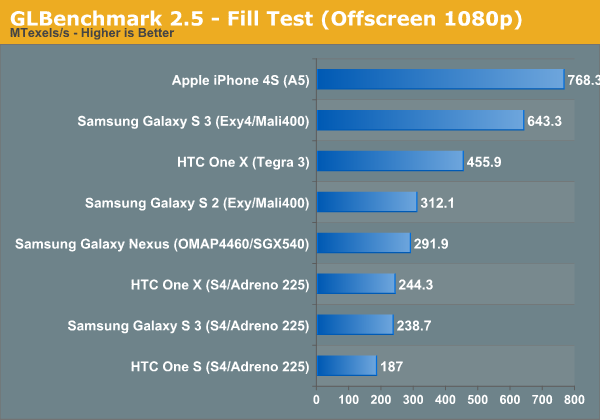
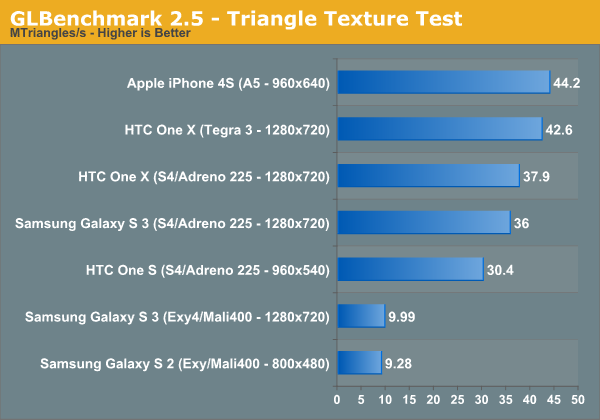
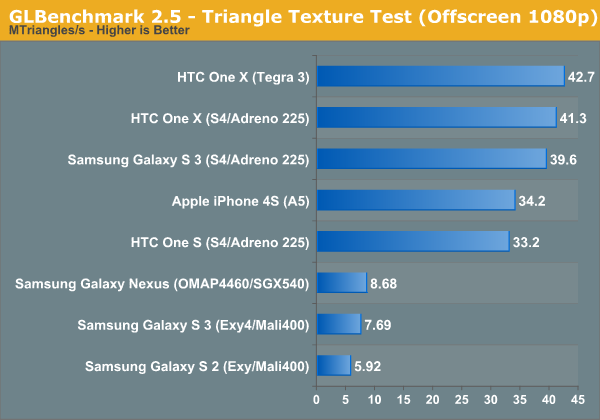

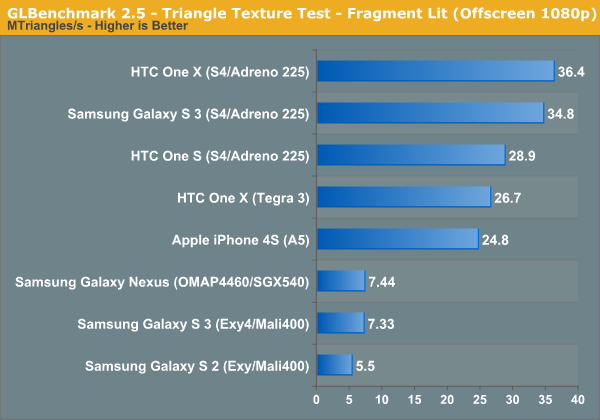
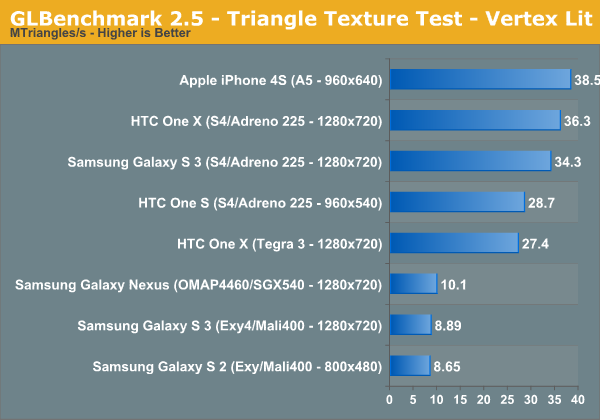
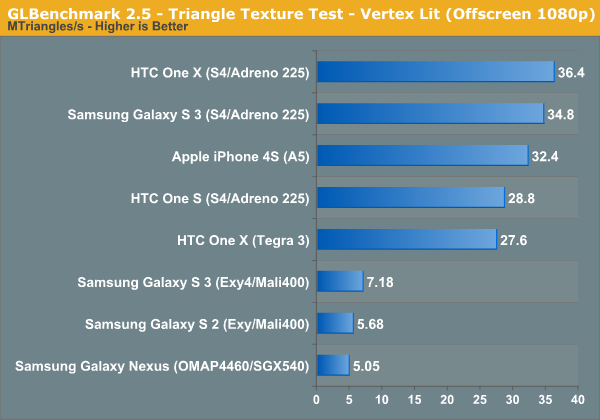
Overall performance using Egypt HD puts all three of the S4 based devices ahead of the iPhone 4S. Ratchet up the resolution to 1080p and the standings don't really change, although the Exynos 4 quad moves up in the world a bit.

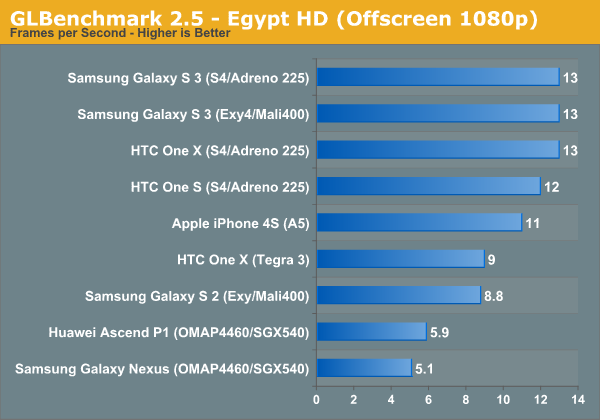
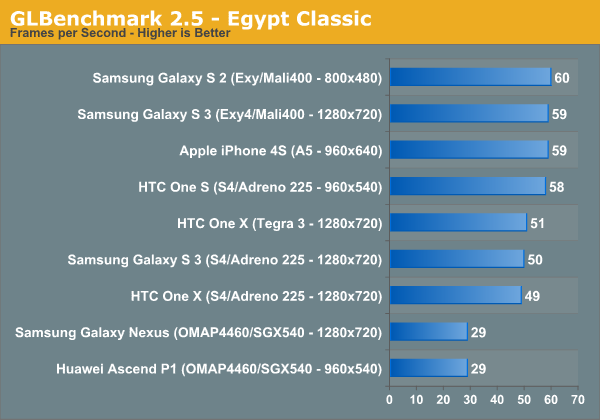

Final Words
The addition of iOS results to our GLBenchmark 2.5 charts doesn't provide much surprise. On the tablet side, Apple's A5X continues to be the benchmark to beat. The A5 however, especially in the iPhone 4S, shows its age in Egypt HD. Qualcomm's S4 and Samsung's Exynos 4 Quad both offer better graphics performance than the A5 in Egypt HD. The pressure is on for Apple to deliver something between the A5 and A5X in the next generation iPhone this fall.










57 Comments
View All Comments
tipoo - Wednesday, August 1, 2012 - link
"most important performance category" isn't objective. Some would say CPU performance is more important.Mike1111 - Tuesday, July 31, 2012 - link
"The pressure is on for Apple to deliver something between the A5 and A5X in the next generation iPhone this fall."Well, Apple just needs to clock the 32nm A5 in the iPhone 50% higher (to 1.2GHz, just 20% higher then the A5 in the newer iPad 2) to be consistently on top again. But 100% (to 1.6GHz) would be better. Too bad the really big jump in performance will probably have to wait until 2013 with a dual/quad-core big.LITTLE and Rogue.
ltcommanderdata - Tuesday, July 31, 2012 - link
50% clock speed bump may be good enough against current SoC at the time of launch, but with Adreno 320, Tegra 3+ T37, Wayne, and Mali-T604 around the corner, Apple's going to need to do better than that to hold the GPU performance crown into 2013.dagamer34 - Wednesday, August 1, 2012 - link
A 50% jump in CPU and GPU performance is no slouch, remember that the iPad 3 had zero improvements to the CPU and because of the Retina display, the 543MP4 just barely keeps up with the 2048x1536 resolution increase in anything that heavily relies on the GPU.lilmoe - Wednesday, August 1, 2012 - link
big.LITTLE will come with more of an advantage to Samsung's Exynos than any other SoC ATM. The sole reason being that Exynos 5 (and beyond) is probably the only (announced) chip equipped with the Mali-t604 (and t658) GPU. Other than the advanced GPU features and the unified shaders, ARM's Midgard architecture was developed and fully optimized for load balancing, FPU offloading, and interconnect coherency, some of the major architectural selling points of big.LITTLE (other than the obvious load balancing of low power (cortex a7) and high performance (cortex a15) CPUs).PowerVR's offerings are great, but they're just not as compatible.
DracoNB - Wednesday, August 1, 2012 - link
Anyone else notice some strange stuff going on with the offscreen vs "native" resolutions in the tests?For example:
"new" iPad @ 2048x1536 gets 1857 and offscreen at a lower 1080p (almost 50% less pixels) gets a LOWER score of 1784?
How does that work unless its not really running @ 2048x1536 but is being upscaled?
The Nexus 7 has a similar issue, where it gets a better score when going offscreen to a higher resolution.
amdwilliam1985 - Wednesday, August 1, 2012 - link
Great catch.I wouldn't be surprise an unethical company such as Apple doing unethical stuff.
darkcrayon - Wednesday, August 1, 2012 - link
Even though he said the Nexus 7 had the same "problem"?Nevermind, I see you're the same one trolling up the rest of the comment section with gibberish.
UltraTech79 - Wednesday, August 8, 2012 - link
Oh god, get the fuck over yourself. No every benchmark issue is somehow some evil corporate conspiracy. Get your head checked. People like you, doesn't matter what brand they love/hate, have metal issues. Come back to realityjadawgis732 - Wednesday, August 1, 2012 - link
Unrelentless is not a word, it's just terrible English.